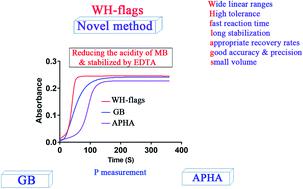当前位置:
X-MOL 学术
›
Environ. Sci.: Processes Impacts
›
论文详情
Our official English website, www.x-mol.net, welcomes your feedback! (Note: you will need to create a separate account there.)
A novel WH-flags method based on reducing the acidity of molybdenum blue (MB) reaction and stabilization by EDTA for quickly detecting phosphorus in water
Environmental Science: Processes & Impacts ( IF 5.5 ) Pub Date : 2021-4-12 , DOI: 10.1039/d1em00096a Yanghui Xiong 1, 2, 3, 4, 5 , Yuan-Bo Wang 1, 2, 3, 4, 5 , De-Sheng Pei 1, 2, 3, 4, 5
Environmental Science: Processes & Impacts ( IF 5.5 ) Pub Date : 2021-4-12 , DOI: 10.1039/d1em00096a Yanghui Xiong 1, 2, 3, 4, 5 , Yuan-Bo Wang 1, 2, 3, 4, 5 , De-Sheng Pei 1, 2, 3, 4, 5
Affiliation

|
There are two popular methods to measure reactive phosphorus (P) and total P: the GB11893-89 method in China and the 4500-P E method of the APHA in the US. However, their drawbacks, including long reaction time and narrow linear range, cannot satisfy the demand for modern analytic techniques. Here, based on reducing the acidity of the molybdenum blue (MB) reaction, and then stabilizing with EDTA, we have developed a novel method (WH-flags) to quickly measure both reactive P and total P. In the WH-flags method, “W” stands for Wide linear ranges (0–1.4 mg L−1 for reactive P & 0–1.8 mg L−1 for total P), “H” stands for High tolerance of different matrices (it can be adapted to a wide spectrum of samples), “f” is fast reaction time (2 min), “l” is long stabilization (40 min), “a” stands for appropriate recovery rates (89.1–103.2%), “g” is good precision and accuracy (CVs < 5% & Res < 5%) and “s” is small volume of samples (5–10 mL). The WH-flags method showed good linearity (R2 > 0.999). The WH-flags method should have broad application in monitoring P from different aqueous samples in the future.
更新日期:2021-04-21


























 京公网安备 11010802027423号
京公网安备 11010802027423号